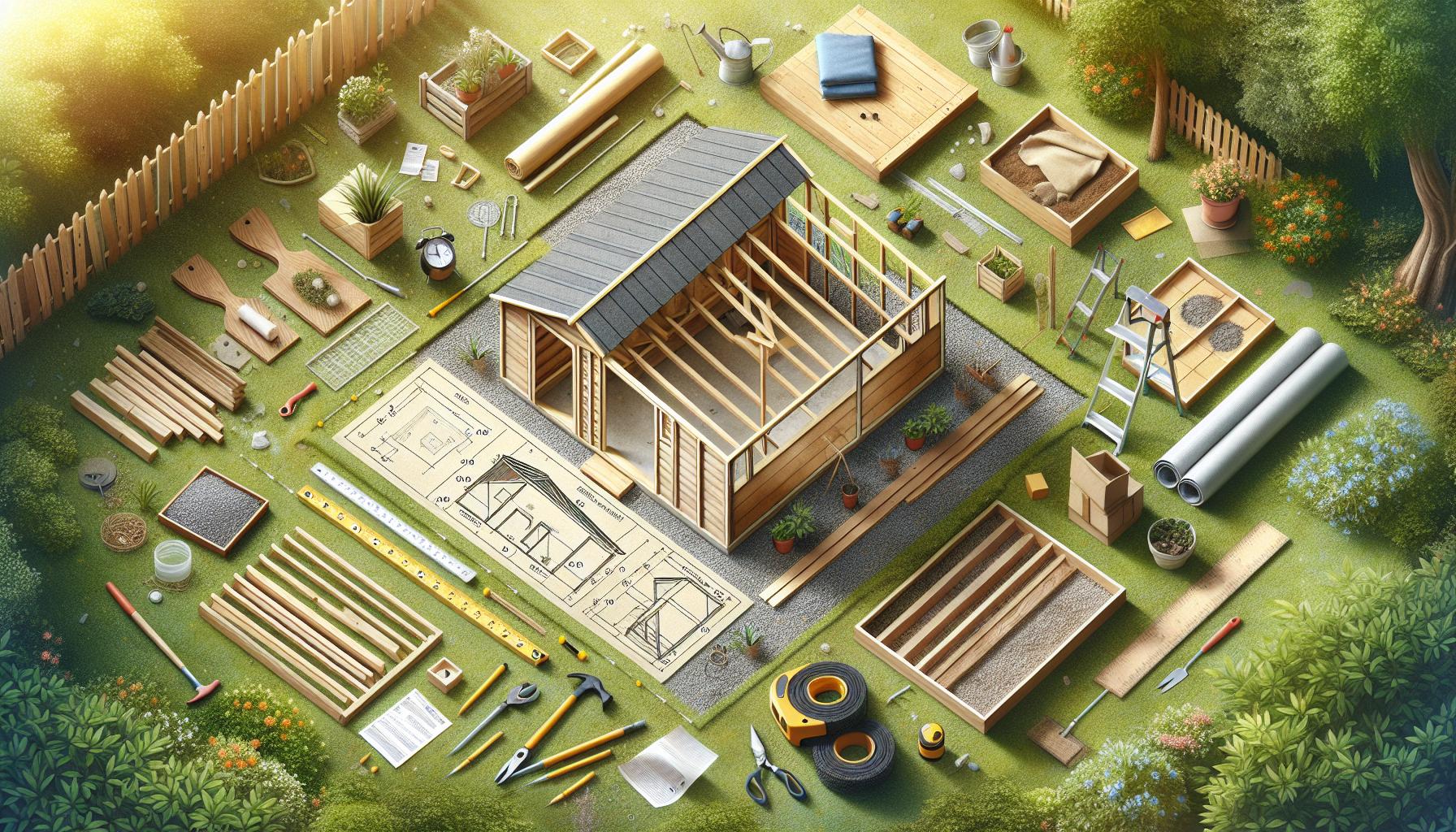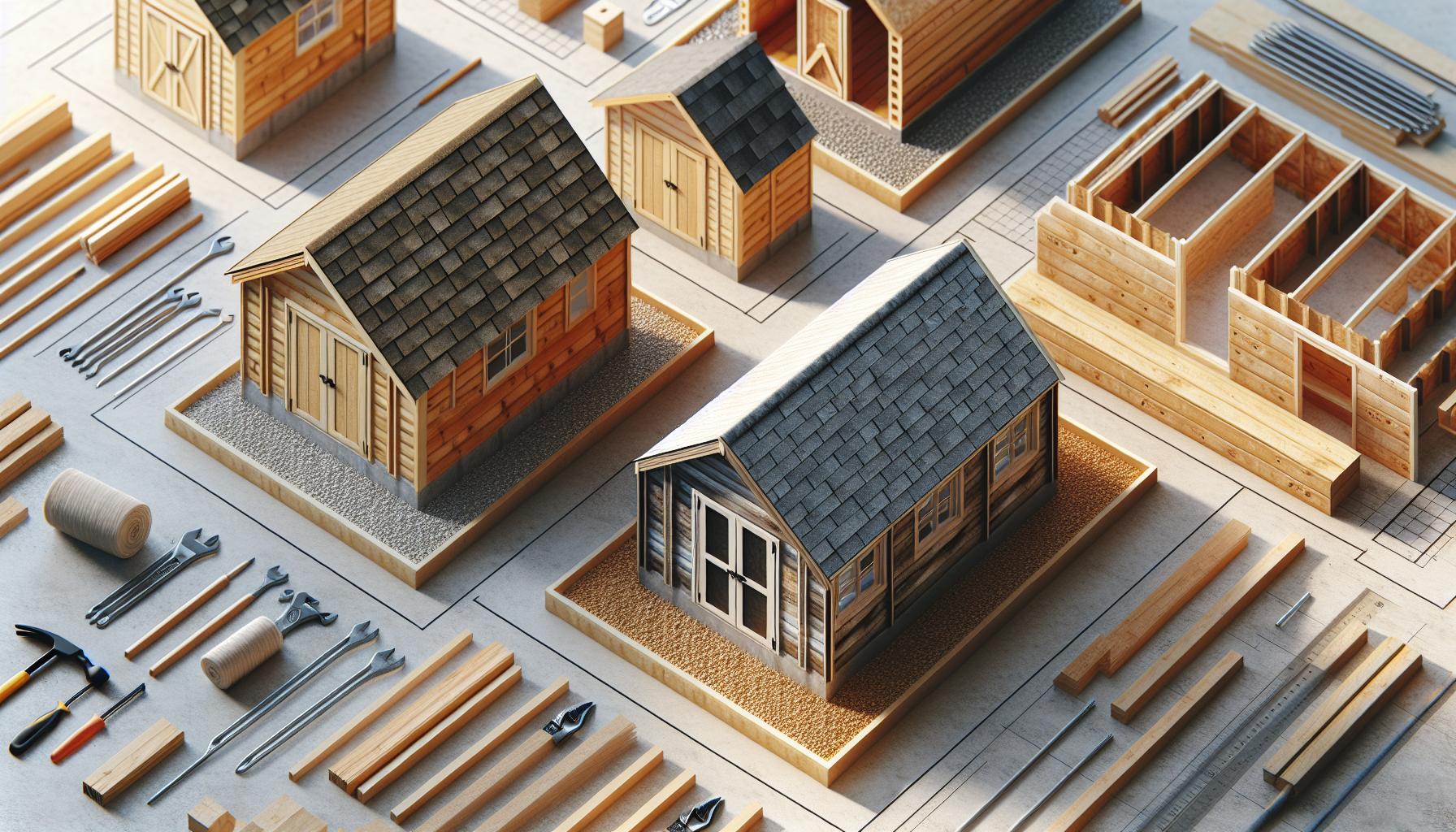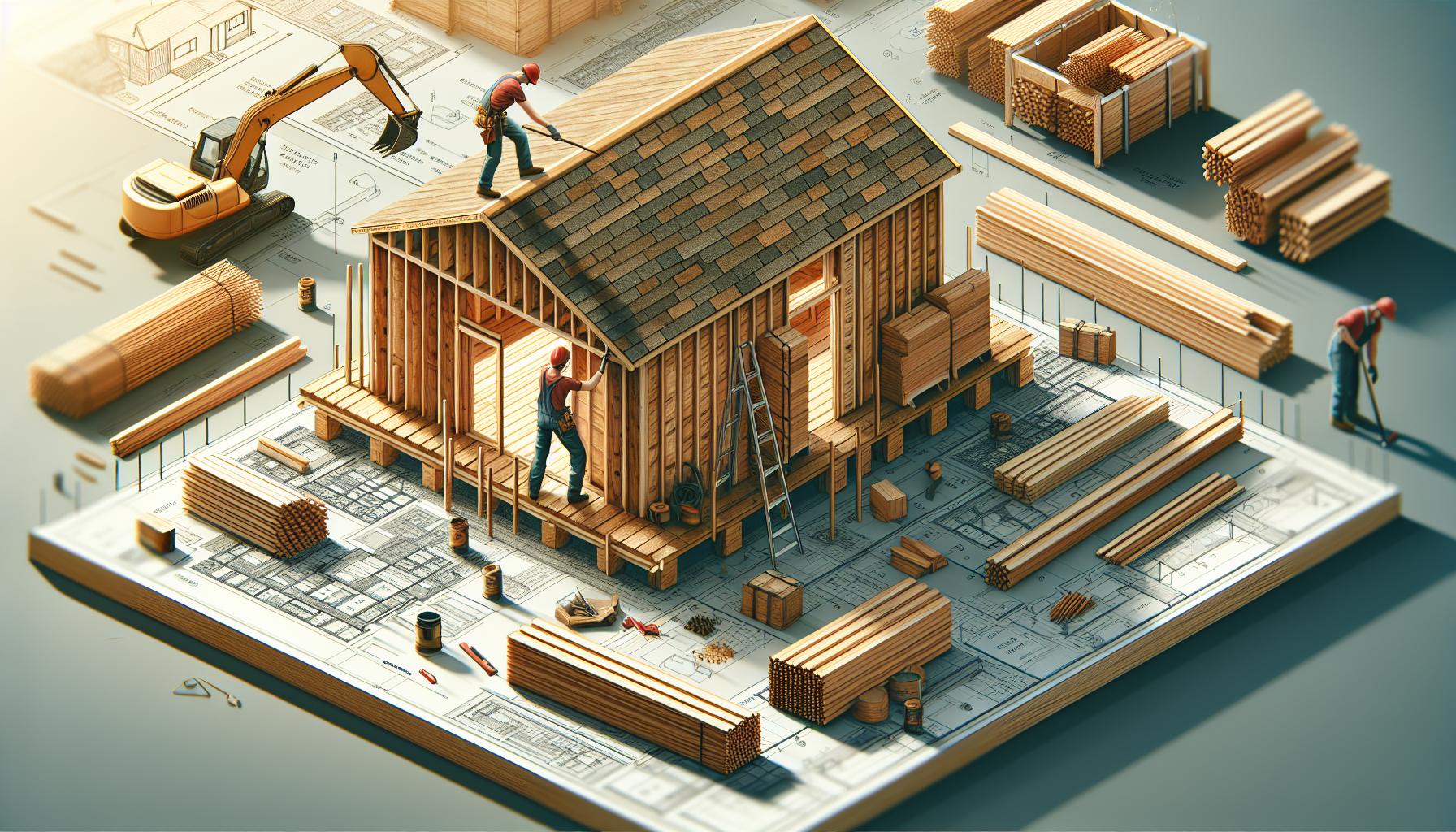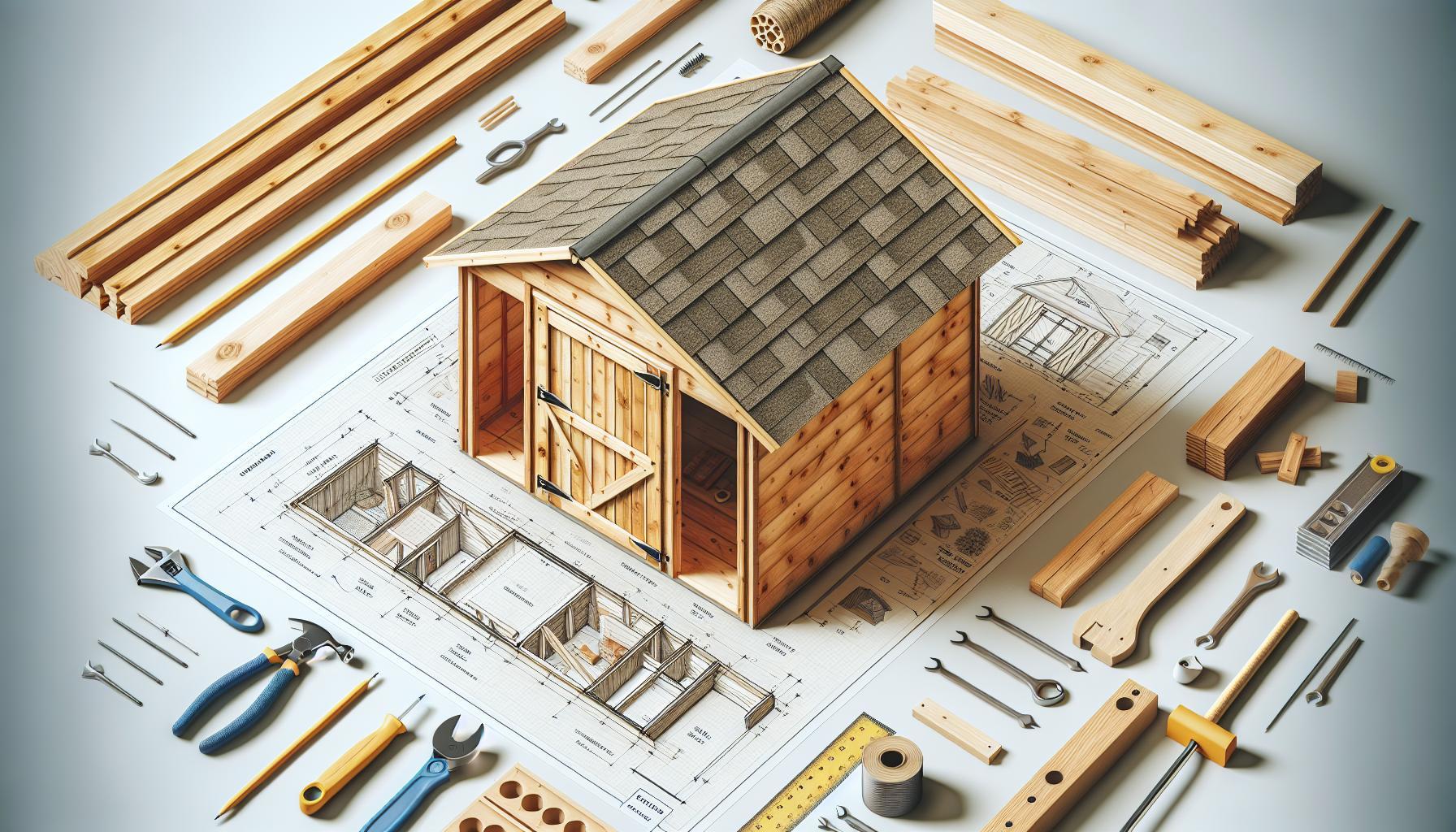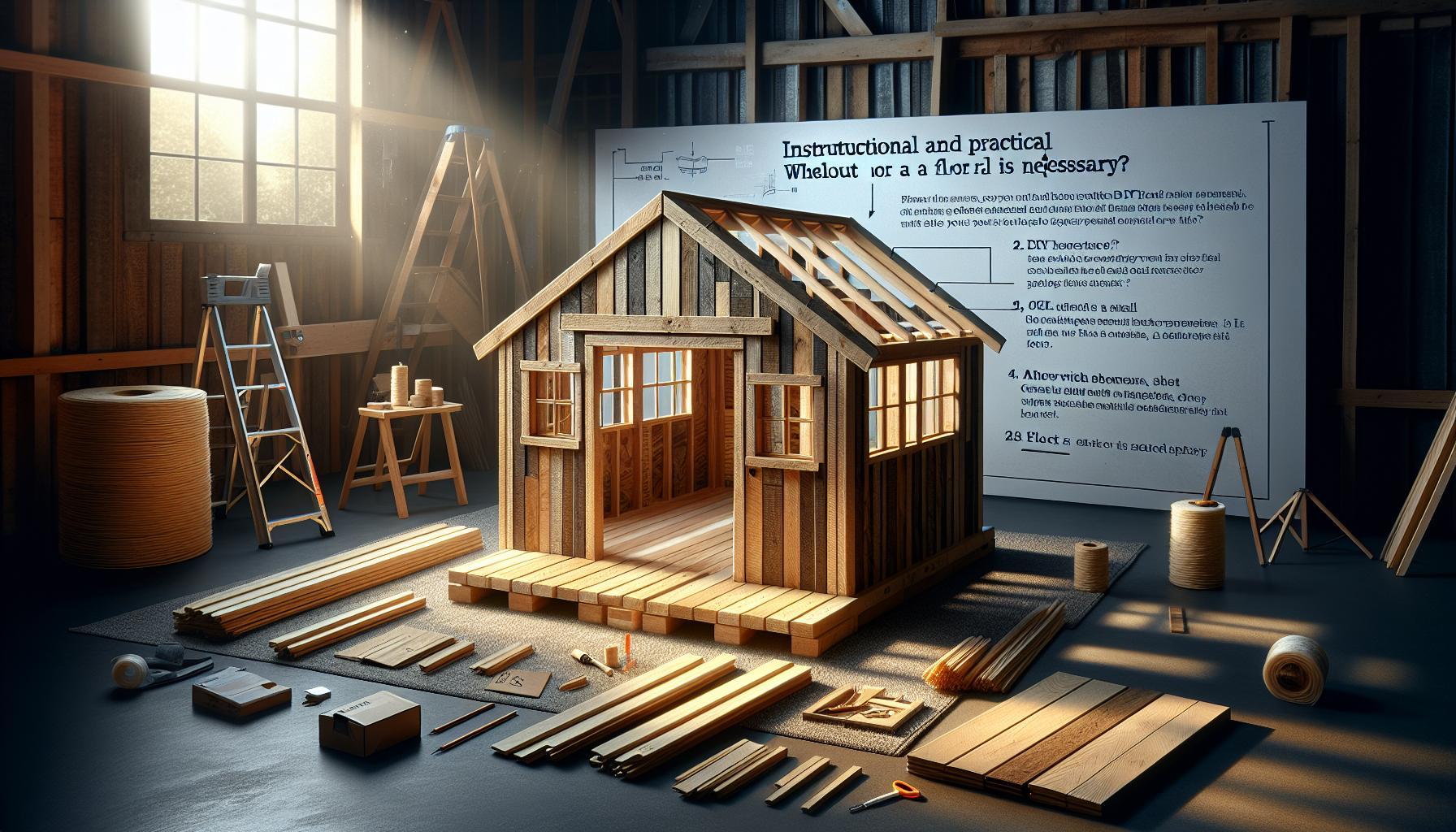Building a solid base for your shed is crucial to its longevity and usability, yet many overlook this essential step. Choosing the right foundation type—be it gravel, concrete, or treated wood—ensures stability and durability, tailored to your specific terrain. This article will guide you in selecting the perfect foundation to protect your shed investment.
Understanding Your Terrain: Assessing Soil and Drainage Conditions
Understanding the soil and drainage conditions on your property is crucial for constructing a durable and stable shed foundation. Poorly drained soil can lead to problems such as uneven settling, moisture damage, and ultimately a reduced lifespan for your shed. Therefore,before deciding on the construction type,it’s imperative to assess your terrain comprehensively.
One effective way to evaluate soil drainage is through a simple test that you can perform yourself. Dig a hole approximately one foot wide and deep in the desired area. Fill this hole with water to allow it to completely drain, then refill it and measure how long it takes for the water to disappear. This can provide insight into your soil’s drainage capacity:
- Fast-draining soils: Drain 1 to 3 inches per hour, ideal for most structures.
- poorly draining soils: Drain less than 1 inch per hour, requiring amendments for shedding safety.
To improve soil drainage,especially in clay-heavy areas,consider incorporating organic matter such as compost,shredded leaves,or farm manure. These materials help create air pockets within the soil, promoting better drainage and water retention at more stable levels. This is especially useful in areas where you plan to place supports for your shed foundation, ensuring that water does not pool and compromise your structure over time.For a more in-depth understanding of your terrain, you might also explore the different types of soil present on your property. Here’s a quick reference table for common soil types and their typical drainage characteristics:
| Soil Type | Drainage Rate |
|---|---|
| Sand | Excellent – drains quickly |
| Silty soil | Moderate – holds moisture well |
| Clay | Poor – drains slowly,prone to waterlogging |
| Loam | Ideal – balances drainage and moisture |
before initiating your shed construction,focusing on assessing your soil’s drainage not only prepares you for the building process but also helps you select the most suitable foundation type for your specific terrain. Understanding these factors can lead to better decision-making that impacts the longevity and functionality of your shed.
Choosing Between Concrete, Gravel, and wooden Foundations
When it comes to selecting the ideal foundation for your shed, understanding the differences between concrete, gravel, and wooden options is critical. Each foundation type has unique characteristics that influence durability, ease of installation, and suitability for various terrains. Choosing the right type not only enhances the longevity of your shed but also ensures stability and resistance to weather conditions.
Concrete Foundations
Concrete foundations are among the most durable choices available, offering excellent support for a variety of shed sizes. They can be poured as a slab or set into footings, providing a robust barrier against moisture. Concrete is particularly beneficial in areas prone to heavy rain or snow, as it prevents the rotting and instability that can occur with othre foundation types. however, installation can be labor-intensive and may require special tools or equipment, making it a better choice for those willing to invest time and effort upfront.
Gravel Foundations
Gravel foundations provide a quick and effective solution for those seeking a more affordable and flexible option. A gravel pad is easy to install and can drain excess moisture, reducing the risk of water damage. This type of foundation is ideal for sheds that do not need to support heavy loads. However, for larger or more permanent structures, gravel may not offer the same level of stability as concrete. Proper depth and compaction are essential for creating a suitable gravel foundation, typically requiring at least 4 to 6 inches of gravel.
Wooden Foundations
Wooden foundations, including skids or a raised platform, are particularly popular for smaller sheds. This option is lightweight and can be easily adjusted or moved if needed. Wooden foundations can elevate the structure above ground level, preventing moisture from compromising the shed’s integrity. However, they are susceptible to rot and insect damage, particularly in moist environments, and may require ongoing maintenance or replacement over time. it is crucial to use pressure-treated lumber for longevity and to ensure proper ventilation under the shed.
| Foundation Type | Durability | Installation effort | Cost | Best For |
|---|---|---|---|---|
| Concrete | Very High | High | $$$ | Heavy loads, wet areas |
| gravel | Moderate | Low | $$ | Small to medium sheds |
| Wooden | Low to Moderate | Medium | $ | Small, portable sheds |
selecting the right type of shed foundation—whether concrete, gravel, or wood—depends on your specific needs, budget, and the environmental conditions of your terrain. Each option has its merits and drawbacks, making it essential to assess your situation carefully to ensure your shed remains secure and usable for years to come.
Steps to Prepare Your Site for a Shed Foundation
To establish a sturdy and long-lasting foundation for your shed, proper site preparation is crucial. This process goes beyond just clearing an area; it lays the groundwork for your structure’s endurance against the elements, ensuring stability and longevity. Engaging in thoughtful preparation will prevent complications in the future, particularly when selecting the right type of foundation that suits your terrain and climate.
Assess the Site
Begin by evaluating your property. Look for a location that is level or has a slight slope, which promotes drainage and helps avoid water accumulation underneath your shed.Avoid sites that are prone to flooding, or areas that are excessively shaded or densely wooded, as these conditions can lead to moisture problems over time. Take note of the surrounding landscape and how it will affect drainage. Clear any shrubs, trees, or debris that could obstruct the foundation area.
Mark the Area
Once you have chosen a suitable spot, use stakes or spray paint to outline the footprint of your shed. This will help you visualize how the shed fits into the landscape and ensure you’re allocating enough space for access around it. This marking process is essential for maintaining proper dimensions and ensuring that the shed does not extend into any utilities or property lines.
Excavate the Ground
With your designated area marked, it’s time to excavate. remove topsoil to create a flat base for your foundation. Depending on the type of foundation you are constructing—whether it be a concrete slab, a skid foundation, or a piers and beams framework—the depth and breadth of your excavation will vary. Typically, you will want to dig down at least a few inches to ensure that the area is below the frost line in colder climates.
Prepare the Base
After excavation, you will need to create a stable base. For a gravel or stone foundation, lay down a layer of crushed stone or gravel, about 3-4 inches thick. This layer acts as a drainage system and helps prevent moisture from accumulating under your shed. Ensure the base is compacted firmly to prevent settling over time. Use a level to double-check that the area is even before proceeding with the construction of your shed foundation.
By committing to these foundational steps when preparing your site, you are well on your way to building a robust and reliable structure that can withstand the test of time and climate. Understanding how to build a shed foundation effectively not only enhances the shed’s lifespan but also maximizes your investment and functionality.
Building a Level Base: Techniques for a Solid Shed Foundation
When constructing a shed, a solid and level foundation is paramount. It not only ensures the longevity of the shed but also affects the functionality and safety of the structure. Neglecting to establish a proper base can lead to uneven floors, structural failures, and frustrations down the line. Here are several techniques to achieve that crucial level base for your shed foundation.
Choosing the Right Materials
To build a reliable foundation, selecting appropriate materials is key. Common options include:
- Concrete blocks: Using solid concrete blocks provides a durable base,especially in areas prone to moisture.
- Gravel: Pea gravel is an effective drainage material that supports stable shed footing.
- Pressure-treated lumber: Using 4×4 pressure-treated lumber for the framing can increase resistance to moisture and pests.
Each of these materials has specific advantages depending on your terrain and local climate conditions. As an example, if you’re working on a sloped site, a combination of gravel and concrete blocks can effectively level the base while allowing for drainage.
Achieving a Level surface
To ensure your foundation is level, follow these actionable steps:
- Site Preparation:
– Clear the area: Remove debris and vegetation where the shed will sit.- Excavate if necessary: Depending on your terrain, you may need to dig down to reach solid ground.
- Use a String Level:
– Set up a string line across the area to establish a level height. Adjust your base untill everything aligns with this line.
- Check Levels Regularly:
– As you lay the foundation, continually check with a spirit level. This will ensure that your blocks or timber remain even throughout the installation.
- consider Drainage:
– Ensure that your base has proper drainage solutions, which can include installing a slight slope away from the shed. This will prevent water accumulation that could undermine your foundation over time.
Real-World Examples
In many DIY shed projects, builders have successfully employed methods that combine different materials. Such as, one method includes setting concrete blocks in a grid pattern, then filling spaces with gravel to create a stable, well-draining foundation. This approach balances stability with durability, especially in areas prone to rainfall or snow.
By following these established techniques, you can construct a strong, level base that meets the requirements of any shed design while remaining adaptable to various terrains. These foundational choices are essential parts of the process described in “How to Build a Shed Foundation: Choose the right Type for Your Terrain,” paving the way for a prosperous building experience.
How to Elevate Your Shed foundation for Better Protection
Elevating your shed foundation is a crucial step in safeguarding your investment. By ensuring that your shed is raised above ground level, you can substantially reduce the risk of water damage, mold growth, and pest infestations, thereby extending the life of your structure.The elevation process not only enhances durability but also fosters better ventilation, creating a healthier environment for stored items.
Choosing the Right Elevation Method
There are several effective methods for elevating your shed, each suited to different terrains and environmental conditions:
- Concrete Blocks: Utilize solid concrete blocks as support pillars. This method is ideal for drainage and stability, allowing air to circulate underneath the shed.
- Timber Skids: For a more customary approach, timber skids can be placed beneath the shed. This method works well in softer grounds, providing a stable base.
- post and Beam: Constructing a post and beam foundation can elevate the shed significantly. This method involves cementing posts into the ground, offering a strong foundation that can handle heavy loads.
- Piers: If you’re dealing with uneven or sloped terrain, installing piers can be an effective solution, ensuring your shed remains level and secure.
Steps to Elevate Your Shed Foundation
Follow these practical steps to effectively elevate your shed foundation:
- Assess the Terrain: Start by evaluating the site for natural drainage and flatness.Choose an area that does not retain water to avoid future problems.
- Gather Materials: depending on your selected method—concrete blocks, timber skids, or piers—procure the necessary materials.
- Prepare the Ground: Clear the area of debris and vegetation to provide a clean workspace and ensure proper placement of your foundation.
- Install Support Structures: Based on your chosen method, carefully place and level your supports. Ensure they are spaced adequately to distribute the weight of the shed evenly.
- Level the Shed: Before securing the shed in place, use a level to make minor adjustments to ensure stability and proper alignment.
By implementing these practices, you can elevate your shed foundation effectively, ensuring protection against the elements and enhancing the overall longevity of your shed. For further insights on selecting the appropriate foundation type for your terrain, refer to resources that detail the various foundation styles available.
Weather Considerations: Preparing Your Foundation for the Elements
When constructing a shed foundation, understanding how weather impacts the structure is crucial to ensuring its longevity and functionality. A well-prepared foundation not only provides stability but also protects your investment against the elements. From heavy rainfall to extreme temperatures, several environmental factors can affect your shed’s foundation; therefore, careful planning is essential.
Assessing Weather conditions
Begin by evaluating the climate in your area. As a notable example, if you live in a region prone to heavy rainfall or snow, establishing a solid drainage system becomes imperative to prevent water pooling around the foundation. Similarly, if your locality experiences freezing temperatures, you need to consider frost-resistant materials and techniques for your foundation. This includes digging deeper for footings to prevent frost heave, which can lift and shift your structure over time.
Key Factors to Consider:
- Rainfall and Drainage: Ensure proper drainage to avoid moisture accumulation.
- Snow Load: Design a roof and structure that can support significant snow weight.
- Temperature Variations: Use materials that can withstand temperature fluctuations to prevent cracking and warping.
Foundation Types for Different Weather Conditions
Choosing the right type of foundation is essential based on the weather conditions you face. For moisture-prone areas, gravel pads or concrete piers can be effective as they allow water drainage while providing solid support. Conversely, in regions with minimal rainfall, a simple wood skids system may suffice but still requires maintenance and checks for rot when exposed to prolonged wet conditions.
Here’s a quick comparison of foundation types tailored to climate considerations:
| Foundation Type | Ideal Conditions | Key advantages |
|---|---|---|
| Concrete Slab | Dry, stable ground | Strong, durable, works well for heavy loads |
| Gravel Pad | Wet or fluctuating soil conditions | excellent drainage, easy construction |
| Block Foundation | moderate rain, stable ground | Good for elevation, supports weight effectively |
| Wood Skids | Dry areas | Cost-effective, easy to install |
By considering these weather-related factors when determining how to build a shed foundation, you not only enhance your shed’s resilience but also extend its usable life, making it a worthwhile investment for years to come.
Common Mistakes to Avoid When Building a Shed Foundation
Building a sturdy foundation for your shed is crucial; it’s ofen the difference between a structure that lasts and one that deteriorates prematurely. Though, many enthusiasts fall into common traps when laying down a foundation. Recognizing and avoiding these mistakes can save you time, money, and significant frustration.
One prevalent error is neglecting to check the ground’s levelness before construction. An uneven surface can lead to significant structural issues down the line, including warping and sagging. Ensure you take the time to use a level to assess your ground; if it’s not flat, consider digging down or adding fill dirt to create a stable base.Additionally, ignoring drainage is another serious misstep. Water pooling around the foundation can lead to rot and infestations. Proper grading away from your shed and using gravel or drainage mats can mitigate these risks.
Another common miscalculation involves the choice of materials. Some builders opt for the cheapest options, which often leads to higher maintenance costs. For example, wood skids left untreated will rot quickly, while concrete blocks might crack under shifting soil. Invest in quality materials that can withstand local weather conditions. Ultimately, a strong foundation begins with choosing the right type for your terrain and ensuring that it’s built with durability in mind.
do not overlook the importance of proper ventilation. A shed foundation without adequate airflow can trap moisture, leading to a breeding ground for mold and mildew. Consider angle bracing and leaving openings to promote air circulation. By staying mindful of these common pitfalls, you can ensure a strong, lasting foundation for your shed that stands the test of time.
Tools and Materials You’ll Need for Your Foundation Project
Building a solid foundation for your shed is crucial, as it not only supports the structure but also extends the longevity of your investment. Ensuring you have the right tools and materials at the outset can make a significant difference in the ease and quality of your project. Whether you opt for a concrete, gravel, or wood foundation, preparation is key to achieving a stable base that withstands the elements.
Essential Tools
Equipping yourself with the proper tools can streamline your foundation-building process. Here’s a helpful list of essential tools you might need:
- Shovel – For digging and leveling the ground.
- Post hole digger – Ideal for setting posts if you choose a pier foundation.
- Level – To ensure your foundation is perfectly horizontal.
- Measuring tape – Accurate measurements are crucial for a proper fit.
- Concrete mixer – If you are pouring concrete, this tool helps in mixing.
- Circular saw – Necessary for cutting lumber to size, particularly for a wooden foundation.
- Pneumatic framing nailer – Speeds up the process of assembling wooden frames.
Building Materials
Selecting the right materials is equally important for the integrity of your shed foundation. Below is a breakdown of common materials based on the type of foundation you choose:
| Foundation Type | Materials Needed |
|---|---|
| Concrete Foundation | Concrete, rebar, gravel for drainage, form boards |
| Gravel Foundation | Crushed stone gravel, landscape fabric, wood skids or beams |
| Wood Foundation | Pressure-treated lumber, concrete footers or blocks, nails, and brackets |
Make sure to plan ahead and gather everything needed before you start your project. Not only will it save time, but it also minimizes interruptions that could compromise the quality of your work when determining how to build a shed foundation that is right for your terrain. By having a thorough list of tools and materials, you’re well on your way to constructing a strong and reliable base for your shed.
Frequently asked Questions
How to build a shed foundation for uneven terrain?
To build a shed foundation on uneven terrain, start by leveling the ground as much as possible. Use gravel or concrete leveling blocks to create a stable base. It’s essential to ensure proper drainage to prevent water accumulation.
After leveling, consider additional supports like piers for further stability. Depending on your shed’s weight and size,a concrete slab might also be an option—this will offer enhanced strength and durability. Always check local regulations regarding foundation types and building codes.
What is the best type of foundation for a shed?
The best type of foundation for a shed depends on the shed’s size and the terrain. Common options include block foundations, concrete slabs, and floating foundations. Each has unique benefits based on stability and drainage.
if your shed is small and lightweight, a block foundation may suffice. For larger sheds, a concrete slab provides a solid, permanent base. Understanding your terrain conditions will help you choose the right foundation type.
Why does my shed need a foundation?
A shed needs a foundation to provide stability, prevent moisture damage, and allow for proper drainage. A well-constructed foundation keeps the shed level and protects it from shifting over time.
Foundations also help with pest prevention by elevating the shed off the ground. Without a proper foundation,the shed may experience issues like twisted walls and roof leaks due to moisture absorption from the ground.
Can I build a shed foundation without concrete?
Yes, you can build a shed foundation without concrete by using treated wood skids or gravel. These methods are effective for lighter sheds and can offer flexibility in installation.
Gravel is porous and drains well, preventing water buildup around your shed. Treated wood skids allow breathing space under the floor, which helps with moisture control and minimizes rot. Ensure to follow best practices for elevation and drainage.
How to choose the best location for a shed foundation?
Choosing the best location for a shed foundation involves assessing factors like sunlight exposure, drainage, and proximity to utility sources. Ideally, the site should be level and free from overhanging branches.
A well-drained area minimizes water pool issues, which can damage the foundation. Moreover, consider local zoning laws and accessibility for future maintenance. For further insights, check out specific building guidelines relevant to your area.
What is the cost of building a shed foundation?
The cost of building a shed foundation varies based on materials and method. On average,a concrete slab can range from $3 to $5 per square foot,while gravel foundations are generally cheaper.
Additional costs may include preparation work and any necessary permits. It’s also wise to budget for tools and supplies. Always consider long-term benefits over initial costs, as a quality foundation extends your shed’s lifespan.
Do I need a permit to construct a shed foundation?
Whether you need a permit to construct a shed foundation typically depends on local building codes. Many areas require permits for larger structures to ensure safety and compliance.
Before beginning your project, check with your local building authority to inform you about specific requirements or zoning regulations that apply to your area. Obtaining the correct permits helps avoid future issues.
The Way Forward
building the right shed foundation is crucial to the longevity and stability of your outdoor structure. Whether you opt for a timber-frame foundation, gravel pad, or concrete slab, understanding your terrain and climate conditions will guide your choice and ensure successful results. Remember, each type of foundation has its own set of benefits, so consider factors such as moisture levels and ground stability when making your decision. Don’t be discouraged by potential challenges; with the right information and a bit of determination, you can create a strong base for your shed that stands the test of time. We encourage you to explore more about the various foundation types to find the one that best fits your needs, and embrace the satisfaction that comes from crafting quality solutions in your DIY journey. Happy building!

